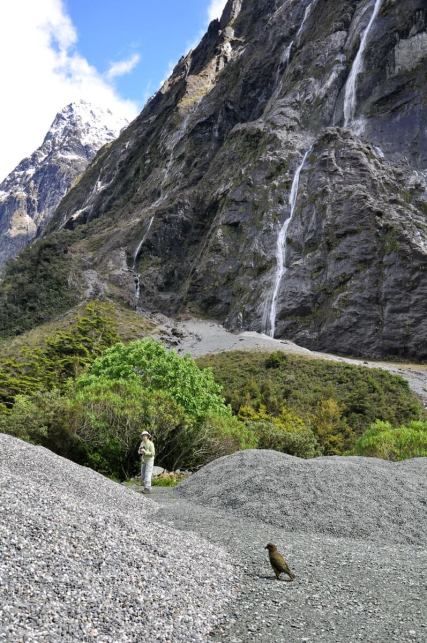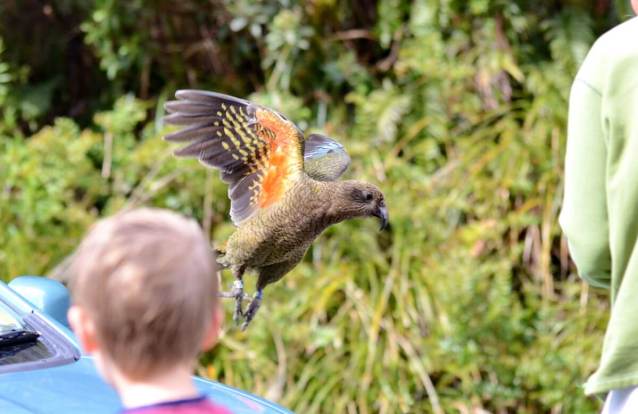Our Encounter with Wild Kea, the World’s Only Alpine Parrot

Fiordland National Park on the South Island of New Zealand abounds with picturesque landscapes. While there, several stops to appreciate the scenery also rewarded us with a couple of special bird sightings. One pullover afforded us the encounter we had hoped for. Several Kea, also known as New Zealand Mountain Parrots, flew in to greet us.
As a staging area for our explorations in Fiordland National Park, Bob and I set up shop at Explorer Hotel in Te Anau. Te Anau is situated on the shores of Lake Te Anau, the largest lake on the South Island and, within New Zealand, it is second in size after Lake Taupo.
As we set off on the first morning of our stay there, we planned to drive through Fiordland National Park to Milford Sound, a fjord with spectacular natural features. Sunny skies prevailed with a brisk and chilly onshore breeze reminding us just how far south we were. Brrr!
As we left Te Anau heading north towards Fiordland National Park, the views were outstanding. Already we were impressed with the distant mountain peaks.
Bordering the main road towards the Park limits were vast expanses of farmland where either deer, sheep or cattle are raised. The play of morning sunshine on the rolling landscape made for some interesting photographs,
but in truth, we snapped photos through the car’s windshield as we hastened onward tempted by the allure of the snow-capped peaks dominating the horizon.
As we entered the glacier-carved wilderness of Fiordland National Park, it was no surprise that clouds were hanging off the mountain tops and even dipping into the valleys below. Reaching to 6,000 feet in some cases, the peaks literally scraped the sky.
Following a recommendation, Bob and I planned to check a few spots en route to see if we might come across some of the endemic alpine parrots. One likely pullover, at Kaka Creek, offered a lovely view of a mountain valley and several peaks.
At first, it seemed that only the terrain was to be appreciated, but then a Kaka appeared out of nowhere and landed in a tree above us. The South Island Kaka is one of two surviving subspecies of this large parrot, with two species already having become extinct.
Kakas are high fliers that feed on sweets in the canopy of the forest. Nectar, fruit, seeds, sap, and honeydew all satisfy the sweet tooth of this parrot. Kakas are endangered and have disappeared from much of their former range due in large part to deforestation.
Continuing further into Fiordland National Park, Bob and I were in our element there in the shadow of sky-high peaks. Lush foliage cushioned the edges of vertiginous drop-offs, and endless numbers of waterfalls cascaded down the countless steep slopes.
When Bob and I pulled over at another scenic spot, it wasn’t the scenery that had us enthralled. It was a trio of Kea. Pretending to have food available for them, I knelt down and immediately got the attention of these endemic parrots.
Kea winter in the river valleys and coastal forests of the South Island’s west coast then move up into the alpine regions of the South Island for the spring and summer. They can be found at altitudes ranging from 900 feet to 6,000 feet.
Kea have learned to associate humans with food and so have become quite emboldened. As a result, a curious Kea approached my hand looking for tidbits, but it was out of luck!
I have to say that I was a little intimidated by the Kea’s sizeable curved beak, especially that long slender upper mandible used to reach food between rocks and in crevices.
Kea are very playful and inquisitive birds with an insatiable urge to explore and manipulate things. Bob and I had been warned to monitor the Kea’s antics around our vehicle.
One Kea was really sizing up our car while we stood back and observed.
Wonder what the Kea was thinking.
Uh, oh! We soon saw what it was up to, and the Kea invited its friends to join in the fun.
Bob and I could see why Kea Parrots are considered “the clowns of the Alps”. Their peculiar way of hopping sideways made me laugh.
Kea will investigate almost any belongings that a hiker or skier might leave unattended, backpacks, footwear or clothing, and they have been known to fly off with small objects.
More relevant to our situation is the fact that these parrots are particularly attracted to the wiper blades…
and rubber trim on automobiles.
Kea Parrots love to get into buildings and even chimneys, so it made sense that one of the Kea poked its head into our car to see if there were any treasures inside. Thank goodness the window was only open part way.
At one point, Bob spotted a songbird near the edge of the parking area. When I went to snap a photo of this South Island Tomtit,
one of the Kea was intrigued and followed along.
Having had no success at panhandling, the Kea lost interest in me and entered into the shadows of a thicket.
There, it proceeded to pluck blossoms from a Fuchsia Tree.
We traveled to New Zealand in Canada’s early winter, New Zealand’s late spring. That is when Kea move from their winter habitat up into the sub-alpine scrub and grassland to feed on the plentiful seasonal fruit, flowers and berries.
The diet of a Kea is made up of a variety of plant and animal matter including carrion, insects, buds, roots, seeds, fruit and blossoms.
Kōtukutuku is one of three species of Fuchsia plant found in New Zealand. It is thought to be the world’s largest species of Fuchsia achieving tree status with a trunk that can reach 39 feet tall and a diameter of over 39 inches.
The nectar-rich flowers of this Fuchsia change from greenish-yellow to purplish-red between August and December. This Kea was quite obviously relishing the sweet nectar at the base of these blossoms.
A Kea is a large parrot measuring about 19 inches long. Most of its plumage is olive-green, which offers good camouflage.
As one Kea preened, the brilliant orange-red feathers on its back and rump became more exposed delighting us with their gorgeous colours.
More tourists pulling off at the viewpoint startled one Kea into flight. That was a bonus because we could see the brilliant orange feathers on the undersides of the wings. Kea look quite magnificent in the air.
Kea are very intelligent birds known to use objects as tools when foraging for food. They have even been seen to fashion tools and work together for the common good when trying to overcome an obstacle. Still, they were fooled when Bob pretended to have food in his hand.
One would not expect an exotic parrot like the Kea to live in the cold and challenging alpine region of New Zealand. It is their intelligence and curiosity that enables them to not only survive but to take pleasure in the harsh mountain environment. Rolling in the snow and bathing in ice-cold puddles are two of a Kea’s favorite activities.
The name Kea is from Māori and is thought to represent the bird’s call. As you can hear in this video, it is an infectious sound that invited mimicking. As endearing as the Kea were with their pleaful warbling vocalizations, we had to shoo them away from our car to avoid damage to the trim and so that Bob and I could continue on our way. We still had a long ways to go to Milford Sound.
Related:
https://frametoframe.ca/2019/01/our-cold-wet-hike-to-fox-glacier-in-new-zealand/
Geothermal Wonders at Te Puia Geothermal Preserve near Rotorua, New Zealand




































